Module 2 Education Unit 3 Language in use 课件(共28张PPT)
文档属性
| 名称 | Module 2 Education Unit 3 Language in use 课件(共28张PPT) | 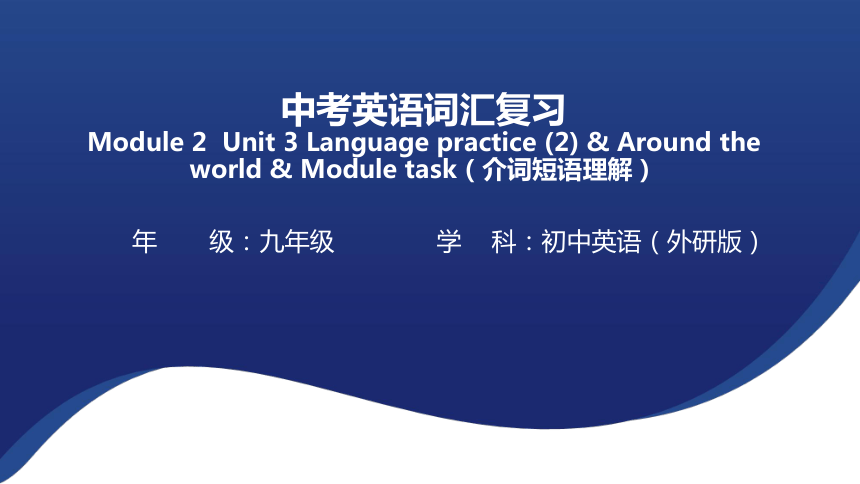 | |
| 格式 | pptx | ||
| 文件大小 | 437.2KB | ||
| 资源类型 | 教案 | ||
| 版本资源 | 外研版 | ||
| 科目 | 英语 | ||
| 更新时间 | 2024-05-22 19:02:50 | ||
图片预览

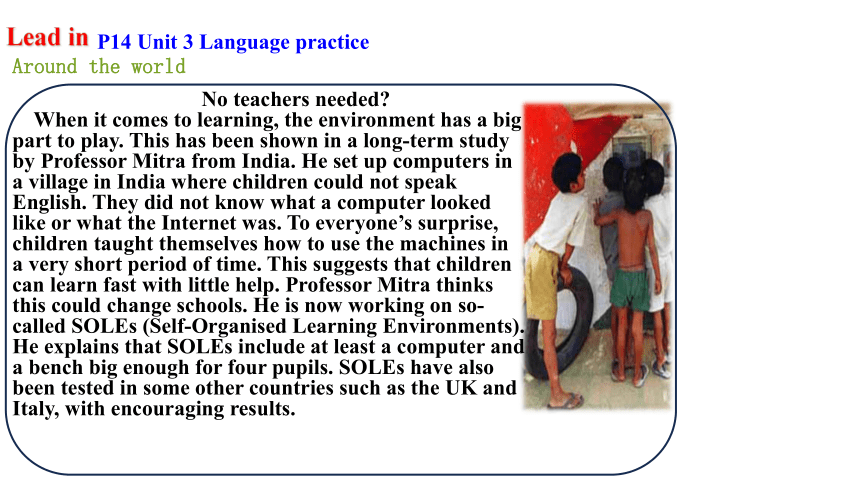
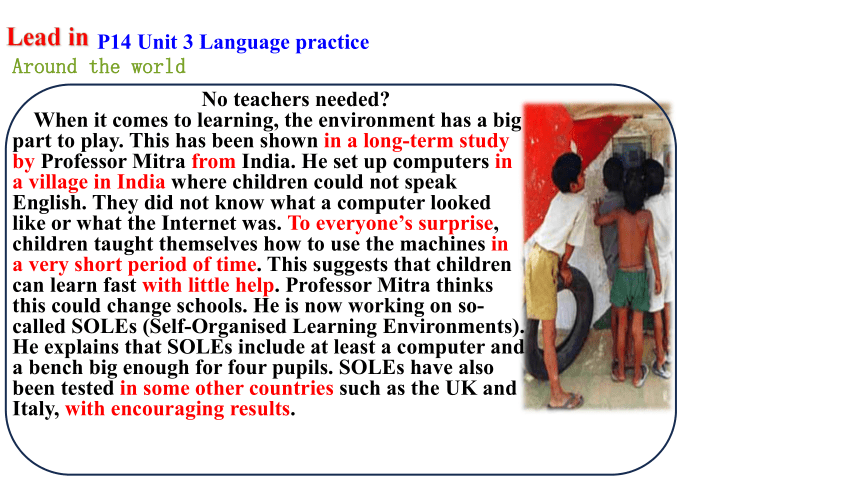
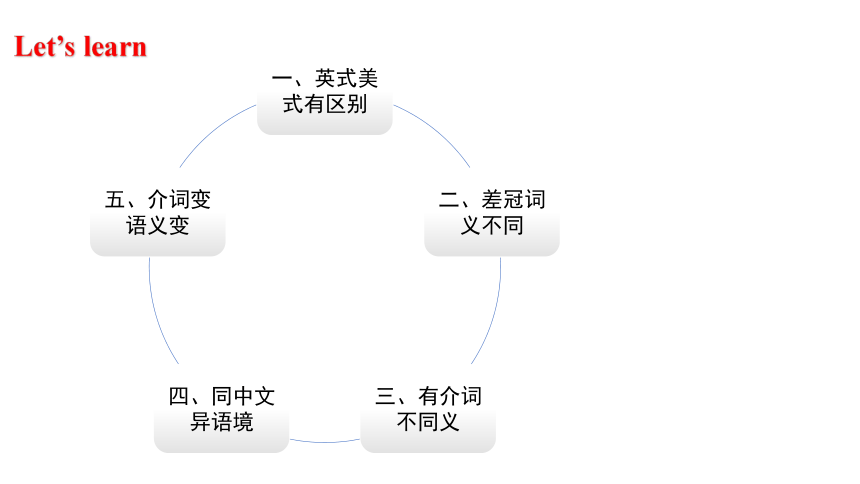

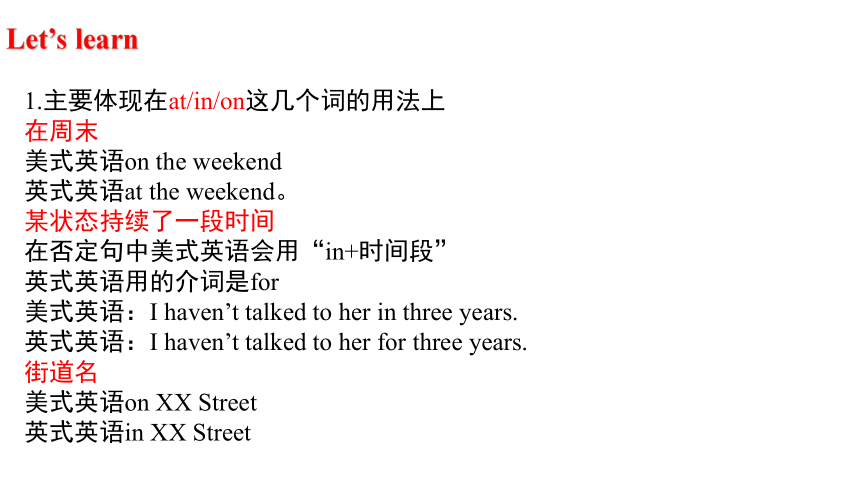


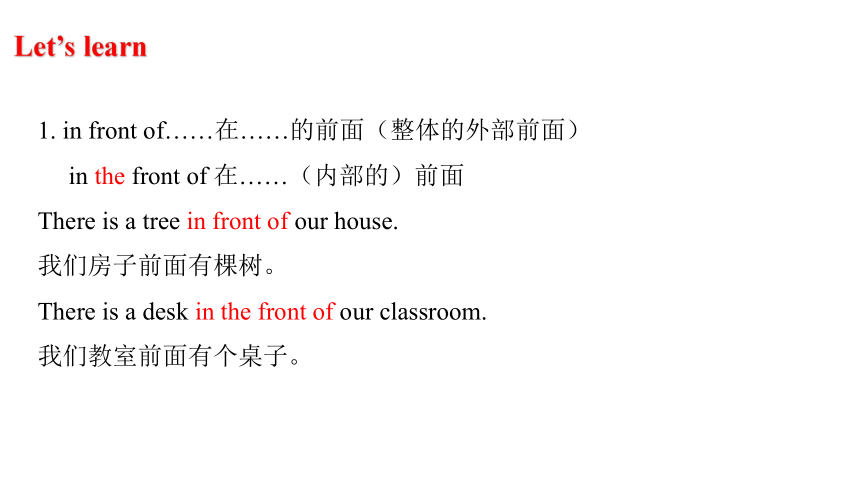
文档简介
(共28张PPT)
中考英语词汇复习
Module 2 Unit 3 Language practice (2) & Around the world & Module task(介词短语理解)
年 级:九年级
学 科:初中英语(外研版)
P14 Unit 3 Language practice
Lead in
No teachers needed
When it comes to learning, the environment has a big part to play. This has been shown in a long-term study by Professor Mitra from India. He set up computers in a village in India where children could not speak English. They did not know what a computer looked like or what the Internet was. To everyone’s surprise, children taught themselves how to use the machines in
a very short period of time. This suggests that children can learn fast with little help. Professor Mitra thinks this could change schools. He is now working on so- called SOLEs (Self-Organised Learning Environments). He explains that SOLEs include at least a computer and a bench big enough for four pupils. SOLEs have also been tested in some other countries such as the UK and Italy, with encouraging results.
Around the world
P14 Unit 3 Language practice
Lead in
No teachers needed
When it comes to learning, the environment has a big part to play. This has been shown in a long-term study by Professor Mitra from India. He set up computers in a village in India where children could not speak English. They did not know what a computer looked like or what the Internet was. To everyone’s surprise, children taught themselves how to use the machines in
a very short period of time. This suggests that children can learn fast with little help. Professor Mitra thinks this could change schools. He is now working on so- called SOLEs (Self-Organised Learning Environments). He explains that SOLEs include at least a computer and a bench big enough for four pupils. SOLEs have also been tested in some other countries such as the UK and Italy, with encouraging results.
Around the world
Let’s learn
Let’s learn
一、英式美式有区别
美式英语American English
英式英语 British English
1.主要体现在at/in/on这几个词的用法上
在周末
美式英语on the weekend
英式英语at the weekend。
某状态持续了一段时间
在否定句中美式英语会用“in+时间段”
英式英语用的介词是for
美式英语:I haven’t talked to her in three years.
英式英语:I haven’t talked to her for three years.
街道名
美式英语on XX Street
英式英语in XX Street
Let’s learn
Let’s learn
2.英式和美式在使用介词有许多差异:
待在家里
英式: stay at home
美式: stay home
再做一次某件事
英式: do something again
美式: do something over
填写表格
英式: fill in a form
美式: fill out a form
Let’s learn
二、差冠词,义不同
Let’s learn
1. in front of……在……的前面(整体的外部前面)
in the front of 在……(内部的)前面
There is a tree in front of our house.
我们房子前面有棵树。
There is a desk in the front of our classroom.
我们教室前面有个桌子。
Let’s learn
The family are sitting at table , eating happily .
坐在桌边吃饭
The girl is sitting at the table ,how carefully she is reading .
坐在桌边(不一定是吃饭)
2. 地点名词前没冠词,往往表动态行为
地点名词有冠词仅表地点不表示动态行为.
Let’s learn
2. 地点名词前没冠词,往往表动态行为
地点名词有冠词仅表地点不表示动态行为
Tom goes to school happily everyday because he enjoys studying with his classmates.
去上学
Mr. Chen decides to go to the school to know something about his son.
去学校,不一定是上学
Let’s learn
三、有介词,不同义
Let’s learn
1.know sb.
认识某人
know about sb.
了解某人
1.Do you know the girl over there
你认识那边的女孩吗?
2.I can’t talk about the girl because I don’t know about her.
我不能讨论这个女孩因为我不了解她。
Let’s learn
2.shoot …对象
击中某对象
shoot at …对象
向某对象射击
I am sorry to shoot your head.
击中某人
It’s interesting to play a game shooting at the red circle.
向某对象射击
Let’s learn
四、同中文异语境
Let’s learn
自从
since …时间 from…时间
since 指从过去到现在的一段时间,和完成时连用;
from指从时间的某一点开始。
I have lived in Wenzhou since 1995.
I hope you will do homework from today.
Let’s learn
2.在之后
in… 时间 after...时间
in指在一段时间之后,用于一般将来时,也可以指一段时间之内;
after表示某一具体时间点之后,用于一般过去时。
Mr. King will be back in four days.
After six the rain began to stop.
Let’s learn
五、介词变,语义变
Let’s learn
be mad…
be mad at \ about …
I’m mad at the cat because it makes my room in a mess.
很生猫的气
2. I’m mad about the cat because it is so cute.
为它疯狂(它很迷人)
Let’s learn
be afraid …
be afraid for /of…
I’m afraid for my mother who is ill in hospital.
为妈妈担心
2. I’m afraid of my mother who is angry with me.
怕我妈妈
Let’s practice
请看下面的短语理解,正确的
在路上
in the road
英式
2. on the road
美式
√
√
Let’s practice
请看下面的短语理解,正确的
在这个队
1. in the team
英式
2. on the team
美式
√
√
Let’s practice
1. Out of question, it is his book because there is his name on the cover.
2. Being late is out of the question, there is much time left.
看下面的短语有无冠词的情况下如何理解,请进行中文的匹配。
A.毫无疑问
out of question
B. 不可能
out of the question
Let’s practice
A.上床睡觉
go to bed
B.向床走去
go to the bed
1.The woman is going to the bed to check if her son is asleep.
2.Mike, it’s too late , please go to bed.
看下面的短语有无冠词的情况下如何理解,请进行中文的匹配。
Let’s practice
A. believe sb.
相信某人的话
B. believe in sb.信 任某人的人格
1.I believe in my sister , she is so kind that she can’t break the rule.
2.Do you believe the boy that often plays joke on us
看下面的短语有无介词的情况下如何理解,请进行中文的匹配。
A. B. C.
A. B. C.
√
Let’s practice
1.Zhejiang is in the southeast of China.
范围内方向
2.Russia is on the north of China.
毗邻方向
3.Japan is to the east of China.
范围之外方向
看下面的在…的方位的短语,三角为第一个地方,椭圆为第二个地方,请选择示意图。
A. B. C.
√
√
Let’s practice
1.The men players fight for their team.
2.The men players fight against their team.
看下面的不同介词短语如何理解的,请进行中文语义表达。
这群男人为他们的队作战(支持)。
这群男人对抗他们队。
Let’s summarize
介词短语理解的关键五点
中考英语词汇复习
Module 2 Unit 3 Language practice (2) & Around the world & Module task(介词短语理解)
年 级:九年级
学 科:初中英语(外研版)
P14 Unit 3 Language practice
Lead in
No teachers needed
When it comes to learning, the environment has a big part to play. This has been shown in a long-term study by Professor Mitra from India. He set up computers in a village in India where children could not speak English. They did not know what a computer looked like or what the Internet was. To everyone’s surprise, children taught themselves how to use the machines in
a very short period of time. This suggests that children can learn fast with little help. Professor Mitra thinks this could change schools. He is now working on so- called SOLEs (Self-Organised Learning Environments). He explains that SOLEs include at least a computer and a bench big enough for four pupils. SOLEs have also been tested in some other countries such as the UK and Italy, with encouraging results.
Around the world
P14 Unit 3 Language practice
Lead in
No teachers needed
When it comes to learning, the environment has a big part to play. This has been shown in a long-term study by Professor Mitra from India. He set up computers in a village in India where children could not speak English. They did not know what a computer looked like or what the Internet was. To everyone’s surprise, children taught themselves how to use the machines in
a very short period of time. This suggests that children can learn fast with little help. Professor Mitra thinks this could change schools. He is now working on so- called SOLEs (Self-Organised Learning Environments). He explains that SOLEs include at least a computer and a bench big enough for four pupils. SOLEs have also been tested in some other countries such as the UK and Italy, with encouraging results.
Around the world
Let’s learn
Let’s learn
一、英式美式有区别
美式英语American English
英式英语 British English
1.主要体现在at/in/on这几个词的用法上
在周末
美式英语on the weekend
英式英语at the weekend。
某状态持续了一段时间
在否定句中美式英语会用“in+时间段”
英式英语用的介词是for
美式英语:I haven’t talked to her in three years.
英式英语:I haven’t talked to her for three years.
街道名
美式英语on XX Street
英式英语in XX Street
Let’s learn
Let’s learn
2.英式和美式在使用介词有许多差异:
待在家里
英式: stay at home
美式: stay home
再做一次某件事
英式: do something again
美式: do something over
填写表格
英式: fill in a form
美式: fill out a form
Let’s learn
二、差冠词,义不同
Let’s learn
1. in front of……在……的前面(整体的外部前面)
in the front of 在……(内部的)前面
There is a tree in front of our house.
我们房子前面有棵树。
There is a desk in the front of our classroom.
我们教室前面有个桌子。
Let’s learn
The family are sitting at table , eating happily .
坐在桌边吃饭
The girl is sitting at the table ,how carefully she is reading .
坐在桌边(不一定是吃饭)
2. 地点名词前没冠词,往往表动态行为
地点名词有冠词仅表地点不表示动态行为.
Let’s learn
2. 地点名词前没冠词,往往表动态行为
地点名词有冠词仅表地点不表示动态行为
Tom goes to school happily everyday because he enjoys studying with his classmates.
去上学
Mr. Chen decides to go to the school to know something about his son.
去学校,不一定是上学
Let’s learn
三、有介词,不同义
Let’s learn
1.know sb.
认识某人
know about sb.
了解某人
1.Do you know the girl over there
你认识那边的女孩吗?
2.I can’t talk about the girl because I don’t know about her.
我不能讨论这个女孩因为我不了解她。
Let’s learn
2.shoot …对象
击中某对象
shoot at …对象
向某对象射击
I am sorry to shoot your head.
击中某人
It’s interesting to play a game shooting at the red circle.
向某对象射击
Let’s learn
四、同中文异语境
Let’s learn
自从
since …时间 from…时间
since 指从过去到现在的一段时间,和完成时连用;
from指从时间的某一点开始。
I have lived in Wenzhou since 1995.
I hope you will do homework from today.
Let’s learn
2.在之后
in… 时间 after...时间
in指在一段时间之后,用于一般将来时,也可以指一段时间之内;
after表示某一具体时间点之后,用于一般过去时。
Mr. King will be back in four days.
After six the rain began to stop.
Let’s learn
五、介词变,语义变
Let’s learn
be mad…
be mad at \ about …
I’m mad at the cat because it makes my room in a mess.
很生猫的气
2. I’m mad about the cat because it is so cute.
为它疯狂(它很迷人)
Let’s learn
be afraid …
be afraid for /of…
I’m afraid for my mother who is ill in hospital.
为妈妈担心
2. I’m afraid of my mother who is angry with me.
怕我妈妈
Let’s practice
请看下面的短语理解,正确的
在路上
in the road
英式
2. on the road
美式
√
√
Let’s practice
请看下面的短语理解,正确的
在这个队
1. in the team
英式
2. on the team
美式
√
√
Let’s practice
1. Out of question, it is his book because there is his name on the cover.
2. Being late is out of the question, there is much time left.
看下面的短语有无冠词的情况下如何理解,请进行中文的匹配。
A.毫无疑问
out of question
B. 不可能
out of the question
Let’s practice
A.上床睡觉
go to bed
B.向床走去
go to the bed
1.The woman is going to the bed to check if her son is asleep.
2.Mike, it’s too late , please go to bed.
看下面的短语有无冠词的情况下如何理解,请进行中文的匹配。
Let’s practice
A. believe sb.
相信某人的话
B. believe in sb.信 任某人的人格
1.I believe in my sister , she is so kind that she can’t break the rule.
2.Do you believe the boy that often plays joke on us
看下面的短语有无介词的情况下如何理解,请进行中文的匹配。
A. B. C.
A. B. C.
√
Let’s practice
1.Zhejiang is in the southeast of China.
范围内方向
2.Russia is on the north of China.
毗邻方向
3.Japan is to the east of China.
范围之外方向
看下面的在…的方位的短语,三角为第一个地方,椭圆为第二个地方,请选择示意图。
A. B. C.
√
√
Let’s practice
1.The men players fight for their team.
2.The men players fight against their team.
看下面的不同介词短语如何理解的,请进行中文语义表达。
这群男人为他们的队作战(支持)。
这群男人对抗他们队。
Let’s summarize
介词短语理解的关键五点
同课章节目录
- Module 1 Travel
- Unit 1 We toured the city by bus and by taxi
- Unit 2 It's a long story.
- Unit 3 Language in use
- Module 2 Education
- Unit 1 They don't sit in rows.
- Unit 2 What do I like best about school?
- Unit 3 Language in use
- Module 3 Life now and then
- Unit 1 They sometimes work harder.
- Unit 2 I think life is better today.
- Unit 3 Language in use.
- Module 4 Rules and suggestions
- Unit 1 You must be careful of falling stones.
- Unit 2 we must keep the camp clean.
- Unit 3 Language in use.
- Revison A
- Module 5 Look after yourself
- Unit 1 We'd better get you to hospital.
- Unit 2 Get off the sofa!
- Unit 3 Language in use.
- Module 6 Eating togethe
- Unit 1 When is the school-leavers' party?
- Unit 2 Knives and forks are used for most Western
- Unit 3 Language in use
- Module 7 English for you and me
- Unit 1 Have you ever been to an English corner?
- Unit 2 We all own English.
- Unit 3 Language in use
- Module 8 My future life
- Unit 1 Here's to our friendship and the future
- Unit 2 I know that you will be better at maths.
- Unit 3 Language in use
- Revison B
